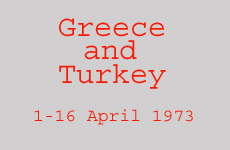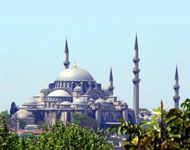|
Page 1 2 3 4 5 6 7 8 9 10 11 12
Sunday, 9 April. After breakfast at the hotel, we took the bus to Lindos, about 30 miles south of Rhodes Town. Although Lindos is now only a small village, at one time it was the island’s capital and most important town. In the time of the ancient Greeks, it boasted a beautiful acropolis in a magnificent setting overlooking the sea. St. Paul visited here (58 A.D.), bringing Christianity to Rhodes. When the Knights of St. John took over the island in the 14th century, they built a fortress on the hilltop, enclosing the remains of the old Greek acropolis as well as an old Byzantine church. As we approached Lindos, we saw a typical Greek village of whitewashed houses wrapped around the lower reaches of the mountain, accenting the dark fortress above. With the smooth blue water just below, it was a beautiful sight.
Alighting from the bus, we were confronted by several Greek men aggressively offering donkey
rides from the parking lot to the hilltop fortress. It was quite a climb, and I persuaded Jane
to ride up on a donkey. In the meantime, I ran up the long flight of steps so I could be there to
photograph her as she arrived. Jane said she didn’t know which was worse, the bumpy ride, or the
donkey’s propensity to walk on the very outside edge of the path so as to leave her staring into
the abyss. Either way, she swore that would be her last donkey ride.
The acropolis had been fortified in succession by the Greeks, the Romans, the Byzantines, the Knights of St John and the Ottomans, then restored (unscientifically) by the Italians. Consequently, it took us a few minutes to sort out the mixture of structures from different eras. The Knight’s fortress (with Italian restorations) easily dominated. The Greek acropolis (6th-3rd centuries B.C.) apparently had been quite elaborate in its day, but not much of it remained. Remnants of the Temple of Athena (300 B.C.) stood near the edge of the cliff overlooking the sea. Like many Greek religious shrines, it had a theater on the hillside. It seated 1,800 people, but that was also in ruins.
We caught the bus back to Rhodes town, had a quick lunch, and walked to our hotel. We finished packing and took a taxi to the airport for our afternoon flight to Iraklion (Heraklion), Crete. We were sorry to be leaving Rhodes so soon. It was such a lovely and interesting place. We promised ourselves we would come back for a longer stay. The weather was beautiful, and our flight to Crete was smooth and uneventful. We took a taxi to the Park Hotel in central Iraklion. By the time we checked in, it was after 18:00. We would be leaving Crete again in barely 24 hours. We had come solely to see the Minoan ruins at Knossos, just outside town. We quickly looked over the tour brochures at the hotel desk, and asked the clerk to book us on a morning bus tour to Knossos. We would also have to visit a travel agent tomorrow to buy our ferry tickets for the trip back to Piraeus tomorrow evening. (Travelers can buy tickets or make reservations for ferries sailing from Crete only from travel agents in Crete.) We had dinner at the hotel. Page 1 2 3 4 5 6 7 8 9 10 11 12
Copyright © 2000-2023 DarrellPeck.com All rights
reserved. | ||||











